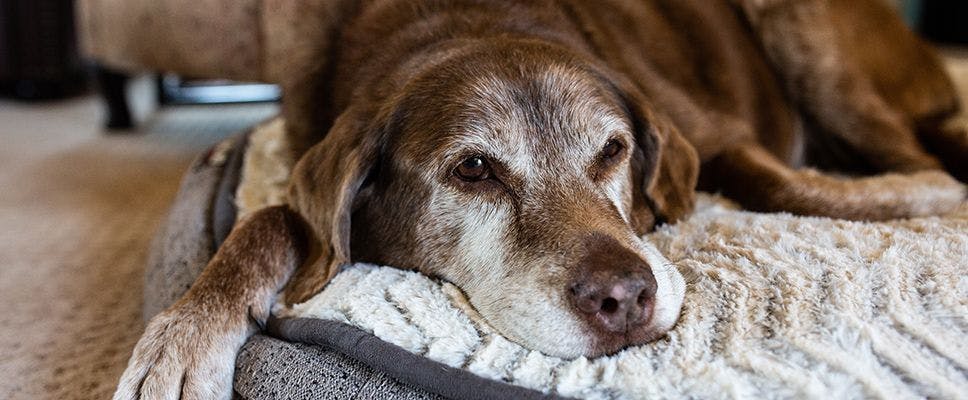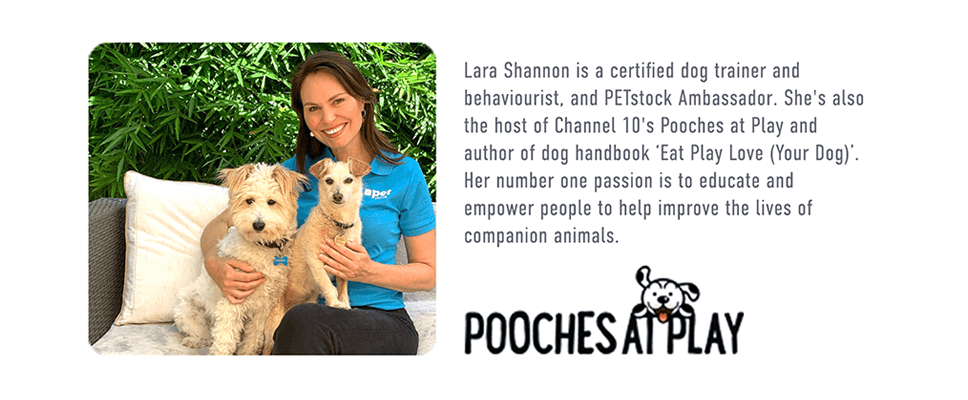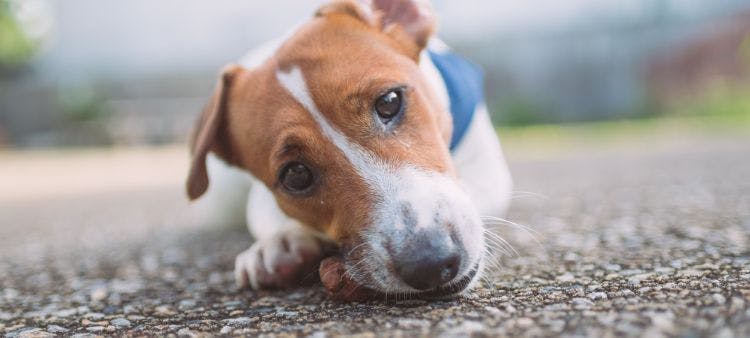
Are you concerned your pup is feeling a little on edge or naughty for no apparent reason? Well, there may be a reason – and this may be dog anxiety. An anxious dog might display a whole range of different – and not so obvious – behaviours, which is why it’s so important to be attentive to any sudden changes in behaviour or if you notice any quirky behavioural patterns.
To help you understand and identify the signs of dog anxiety, we’ve put together a quick guide on the signs and treatments, with the help of certified dog behaviourist, and host of Pooches At Play, Lara Shannon.

It’s been estimated that more than 30% of dogs are now suffering from stress or anxiety and, as a trainer, I see a lot of issues such as fear aggression, barking, digging and destructive chewing happening as a direct result of stress and anxiety in dogs and cats, says Lara.
What Does Dog Anxiety Look Like?
Dog anxiety isn’t always easy to identify. Although we can’t directly understand our dog’s inner thoughts and musings (although we’d like to think we can), there are always outward behaviours which are detectable.
In general, anxious animals appear tense and look apprehensive or vigilant/prepared for an event that is coming. Whether the threat is real or not doesn’t matter to your dog. For them, the threat IS very real and we, as responsible and loving owners, should take action to help reduce any stress triggers or remove them from the situation, but in a way that doesn’t reinforce the anxiety further, says Lara.
Common Types Of Dog Anxiety
Although the expressions of dog anxiety might crossover and look similar, there are different types of anxiety your dog may be experiencing:
Separation Anxiety
Anxious behaviour triggered by a dog being left alone for periods of time without their owner or playmate. This can lead to destruction of items in your home while they’re left alone, excessive barking, or even attempts to escape their confinement.
Fear-Based Aggression and Anxiety
Anxiety that outwardly displays aggression due to fear. This type of anxiety can be caused by a previous event in the dog’s life, or due to lack of socialisation at the early stage of a dog’s puppy years.
Compulsive Disorders
Like humans, dogs can also develop anxiety in the form of compulsive behaviour disorders. The type of behaviour associated with this type of dog anxiety must be excessive, repetitious and affects regular daily functioning. A disorder like this can include obsessive licking of body areas/parts, biting of tail frequently, chewing a particular toy constantly without breaks, frequent tail chasing and more.
Signs Of Dog Anxiety

Does your dog bark non-stop when you close the door behind you? Or, maybe, begins to freeze when strangers’ approach? These types of behaviours can be signs of anxiety in your dog and need to be assessed in conjunction with any situational circumstances.
Barking
Barking is generally how most of us think our dog is communicating however you may find their barking can be a way of communicating their anxiety – especially if the barking occurs along with any other anxious behaviour – such as a stiff body. A stiff body and high-pitched barking together might be a warning that your dog may become reactive, which can be the outward sign of a deeper anxiety-based issue.
Licking of lips
When a trigger occurs for a dog with anxiety, you may notice a rapid licking of lips or flicking of the tongue, which can signal unrest for the dog.
Yawning
In conjunction with the licking of lips or tongue flicks, an anxious dog may also start yawning – when they’re not tired.
Pacing
If your dog constantly paces around you or appears to stick to you like glue, this might mean they are overly attached to you and may fear leaving your side, stemming from a form of separation anxiety.
Panting and whining
All dogs pant when they’re worked up and tired from exercise, but if they’re panting when they’re stationary or just hanging around beside you, that may be a sign of an anxious dog. And, while dogs may whine if they want food or your attention, they might also be whining because they’re anxious of a particular situation – that’s why it’s essential you have an understanding of the situational elements associated.
Chewing, destruction and digging
If you’ve noticed your dog rapidly chews, digs up your garden or destroys not only their toys, but your favourite household items, then this may be a sign of anxiety - in particular - separation anxiety. If this behaviour occurs while you’re not home, it could also be a sign of boredom, too. So, if you can, find out if they’re also barking or howling before or after destroying things when you’re not home, as these can be associated behaviours of anxiety.
Most dogs I have seen where digging has become a problem behaviour can be put down to boredom or anxiety. If it is anxiety related then this would often be accompanied by other Separation-Related Behaviours such as barking, howling, crying, excessive greetings, pacing, inappropriate elimination, loss of appetite, says Lara.
Disinterest in food and water
If you notice your dog has stopped eating in certain situations, such as while they’re at a boarding kennel or left at home alone, this may be because they’re preoccupied with worry or anxiety. If you notice any issues with your dog’s interest in food, please seek from your local Petstock VET.
How To Treat Dog Anxiety
Establish a routine
Establish a strong daily routine, if you can (and your lifestyle permits), as this will ensure your dog can have a sense of safe familiarity. This means coordinating your mealtimes, playtime and rest time. Having a regular routine will allow your dog to understand what to expect every day and help them feel content and relaxed.
Change your exit strategy
Although having a routine can add calmness to a dog’s day, it can also have the opposite effect if they become too aware of the signs and signals that you’re leaving them alone. Put a strategy in place, and switch up your exit routine, this may prevent your dog from flicking a switch when you pick up your keys, put your shoes on, or unlock your car.
Turn up the tunes
Some dogs with anxiety respond well to some music being played, even while you’re not at home. A touch of music in the background of their day is an effective distraction from silence, and can soothe your dog’s worries.
“You can find there are dog specific CDs out there and radio stations designed to help calm dogs. It’s a great way to block out any noises they might be responding to, so is worth trying as part of a complete enrichment plan,” says Lara.
Avoid anxiety-provoking circumstances
It sounds simple, but actively avoiding anxiety triggers that you are already aware of will help prevent any behaviour turning into a potentially dangerous situation or event.
“When you are in or about to encounter a ‘trigger’ try distracting them before they have the chance to react with a treat, play, obedience exercises to help keep them occupied (and calm) when in the presence of the trigger. If you are dealing with fear-based aggression this needs to be handled correctly and with experience,” says Lara.
Provide them a safe space
If your dog may be triggered by anything in your home environment or outside noises, you must have a space that your dog can retreat if they’re feeling frightened or threatened. Some dogs will love the option of sneaking back into their crate or sleep area.
Try some new toys for added enrichment and comfort
While dogs love to play with their toys, these toys can also deliver a sense of comfort and enrichment. Whether it’s an interactive toy to quell boredom, or a soft toy with a gentle heartbeat to relax. There are so many clever and innovative toys available that might help your dog manage their anxiety or boredom – it’s just important you figure out the root of the anxiety to ensure you’re not at risk of reinforcing the issue.
"When dealing with many common behaviour problems in dogs, ‘environmental enrichment’ is key to providing the stimulation or exercise that they are sometimes missing,” says Lara.
Consider natural anxiety products and vitamins
If you’re interested in trying some natural anxiety products, beyond toys, there are some alternate options available. You can try anti-anxiety collars, anti-anxiety thundershirts and all natural anxiety tablets.
*Note: We always recommend you work with a trained dog behaviourist and vet to manage your dog’s anxiety condition and treatment options. Treatment might include extended training and desensitisation. Further to this, all products featured may not fix or provide a permanent solution to an anxiety condition.
Product Picks For Your Anxious Dog
While you can't always be sure a specific product or method will work to treat your anxious dog, there are plenty of options for testing out what might suit your dog and their specific triggers. Here are some effective product options that might just be the right choice for your pooch.
Why You Should Always Speak To Qualified Dog Behaviourist And VetT
As mentioned throughout this article, you can’t always determine or understand the extent of your dog’s anxiety, even if you see some of the signs and become aware of the triggers. It’s important you speak to a dog behaviourist or your local vet when looking to treat a serious anxiety issue. Most behaviourists and vets will recommend an ongoing training/treatment plan to manage your dog’s anxiety.
Want to speak a vet about your dog's behaviour. Check out our VET Chat
Petstock Vet Chat
If you’re in need of easy, real-time advice, speak to one of our trusted Australian vets, wherever you are, with our Petstock Vet Chat. It’s a convenient online service available seven days a week from 6am until midnight.
Learn more